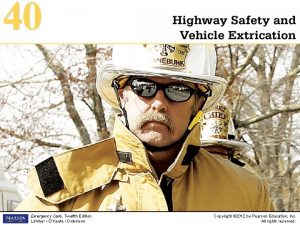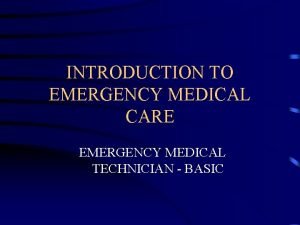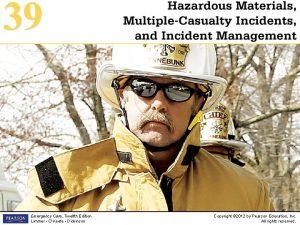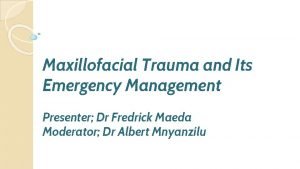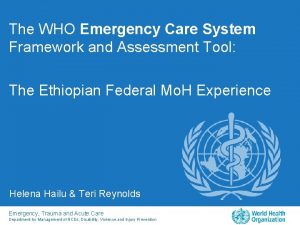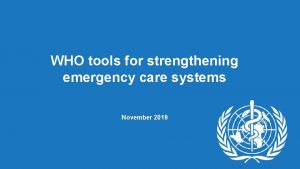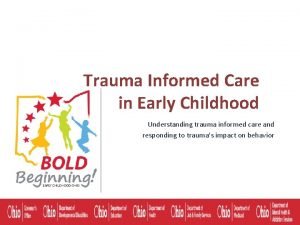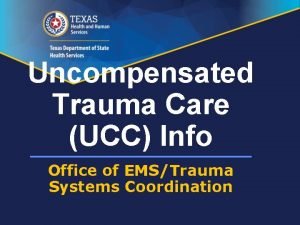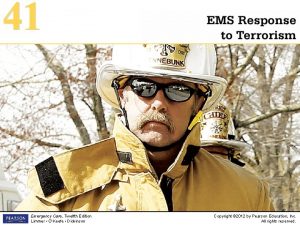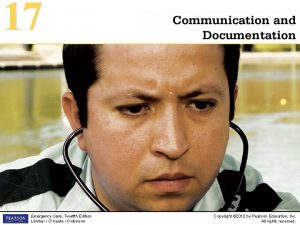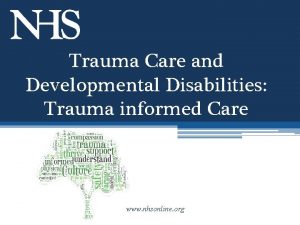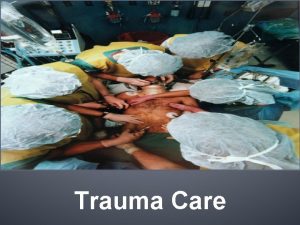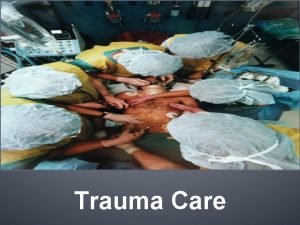Washingtons Emergency Medical Services and Trauma Care System

























- Slides: 25

Washington’s Emergency Medical Services and Trauma Care System: Locally Built, Nationally Recognized Eva Rooks, MA Health Services Administrator/Trainer Health Systems Quality Assurance Division Washington State Department of Health

Objectives Brief history of Trauma System development in WA state Current EMS & Trauma System Importance of regional & local council work Upcoming challenges Your role as a Council member

Trauma System Development 1960’s-1970’s Trauma identified as national epidemic 1970’s – 1980’s Lessons in trauma care learned from wartime being brought to civilian realm

WA EMS & Trauma Act of 1990 § Clear lines of authority and responsibility § Designation of Trauma Care services § Verification of Prehospital Trauma services § Field triage criteria development

Trauma System Development Patient survival and recovery linked to: § A systematic, organized approach § Right patient to the right hospital in the right amount of time

Washington State’s Systems Approach: Continuum of Care System monitoring & evaluation Illness and injury prevention System monitoring & evaluation Emergency Medical Services Rehabilitation System monitoring & evaluation Hospital inpatient care Hospital emergency services System monitoring & evaluation

& Trauma System State EMSEMS and Trauma System ns tio da rm at en m Regional EMS Councils m fo co In Committee Re ion Steering Local EMS Councils Grassroots

EMS & Trauma Care Organizational Snapshot WA State Department of Health • Licensure/Trainin g • Trauma service designation • System evaluation& quality improvement • Trauma Registry • Regional support EMS & Trauma Care Steering Committee Regional EMS & Trauma Care Councils • Advise DOH regarding EMS & trauma care needs to advance the system • Review regional EMS & TC plans • Review proposed or recommend changes to EMS & TC rules • Regional Strategic Plan • Min/max numbers pre-hospital services and hospital designation • Regional Patient Care Procedures • County Operating Procedures • Address emerging issues

Washington State Acute Trauma Services Map 0

Trauma Centers Trauma Center Designation by WA State DOH § Five levels based on standards and resources § Harborview first hospital designated (1993) as a statewide Level 1 § Application process done every 3 years § Funded by Participation Grants from DOH

Trauma Fund (1997) to offset the high costs of trauma care. § New/used vehicle sales fee § Moving violation fee • Funds participation grants

Eight Regional Councils Grass roots, locally driven system § Provide oversight and direction of regional system § Volunteer members appointed by Secretary of Health § Non-profit entity § Funded by contract with WA State DOH to implement work in the regional plan

Benefit of Participation in Regional Council Voice in improving EMS system § Service distribution § Education § Platform for collaboration and sharing of information § Address emerging issues (examples: shrinking resources, merging agencies) § Determine how funding is allotted § Direct ground operations via PCPs and COPs

Responsibility of Regional Councils Develop strategic plans which include: § Work needing to be done to meet the regional system needs during the plan cycle § Recommend changes to minimum and maximum numbers of verified & designated trauma care services § Regional Patient Care Procedures § County Operating Procedures

Benefits to Local Councils § Training Grant funds for agencies § Special projects § Injury prevention projects that benefit local communities

Procedure for Significant Changes Regional Council Recommends Local Council Recommends Approval Steering Committee Advises Approval or Disapproval Department of Health Approves or Denies

Statewide Steering Committee Injury and Illness Prevention Emergency medical services care Hospital emergency services Hospital inpatient care Technical Advisory Committees Injury & Violence Prevention Pre-Hospital Trauma Medical Directors EMS/Cardiac Stroke Hospital/Rehabilitation Cost Reimbursement Quality Outcomes Pediatric Regional Advisory Committee Regional Councils Rehabilitation

Another Systems Approach Cardiac / Stroke System Established § Legislation passed November 2010 § Development to duplicate success of Trauma System § Prehospital triage tools / care guidelines § Rapid transport to closest appropriate care facility § Facility categorization § Cardiac § Stroke § Voluntary participation

Future System Challenges § “Pioneers” of EMS and Trauma Care System leaving the system § System is so seamless the public isn’t aware it is there § Reduced state funding § Reimbursement rates § Highly dependent on volunteers (LIKE YOU!) to make it successful § Decrease in volunteers

You Are the Connector As Regional EMS and Trauma Council member, you have a responsibility to: • • The general public The agency you represent The Department of Health Other Council Members

How You Help § Bring the perspective of those you “represent” to the Council – share what the Council is doing that impacts them § Relay information from the Regional Council to your Local Council and § Attend Council meetings § Participate in committees and workgroups

How You Help § Develop and implement the Regional Plan § Hold yourself and other members accountable for work outlined in the plan § Ensure deliverables are met & Council staff submit deliverables to DOH on time

How the Executive Board Helps Fiduciary oversight Budget oversight Avoid negligence and fraud Be informed Administrative policies Regional plan implementation § Sign all contracts § Hold staff accountable § § §

Never doubt that a small group of thoughtful, committed citizens can change the world; indeed, it's the only thing that ever has. - Margaret Mead

 Introduction to emergency medical care
Introduction to emergency medical care Tdh ems
Tdh ems Introduction to emergency medical care
Introduction to emergency medical care Introduction to emergency medical care
Introduction to emergency medical care Emergency management of maxillofacial trauma
Emergency management of maxillofacial trauma Who emergency care system framework
Who emergency care system framework Interagency integrated triage tool
Interagency integrated triage tool Tertiary level of care
Tertiary level of care What was george washington's phobia
What was george washington's phobia George washingtons terms
George washingtons terms George washingtons presidency
George washingtons presidency Washingtons precedents
Washingtons precedents The federalist era lesson 2 early challenges
The federalist era lesson 2 early challenges Lesson quiz 9-1 the federalist era
Lesson quiz 9-1 the federalist era George washingtons phobias
George washingtons phobias Washington state biomes
Washington state biomes George washingtons domestic policy
George washingtons domestic policy 4 r's trauma informed care
4 r's trauma informed care Lgbt trauma informed care
Lgbt trauma informed care Dr anita ravi
Dr anita ravi 4 r's trauma informed care
4 r's trauma informed care 4 r's trauma informed care
4 r's trauma informed care Libby bergman
Libby bergman Sensory modulation
Sensory modulation Uncompensated trauma care application texas
Uncompensated trauma care application texas Early total care in trauma
Early total care in trauma
